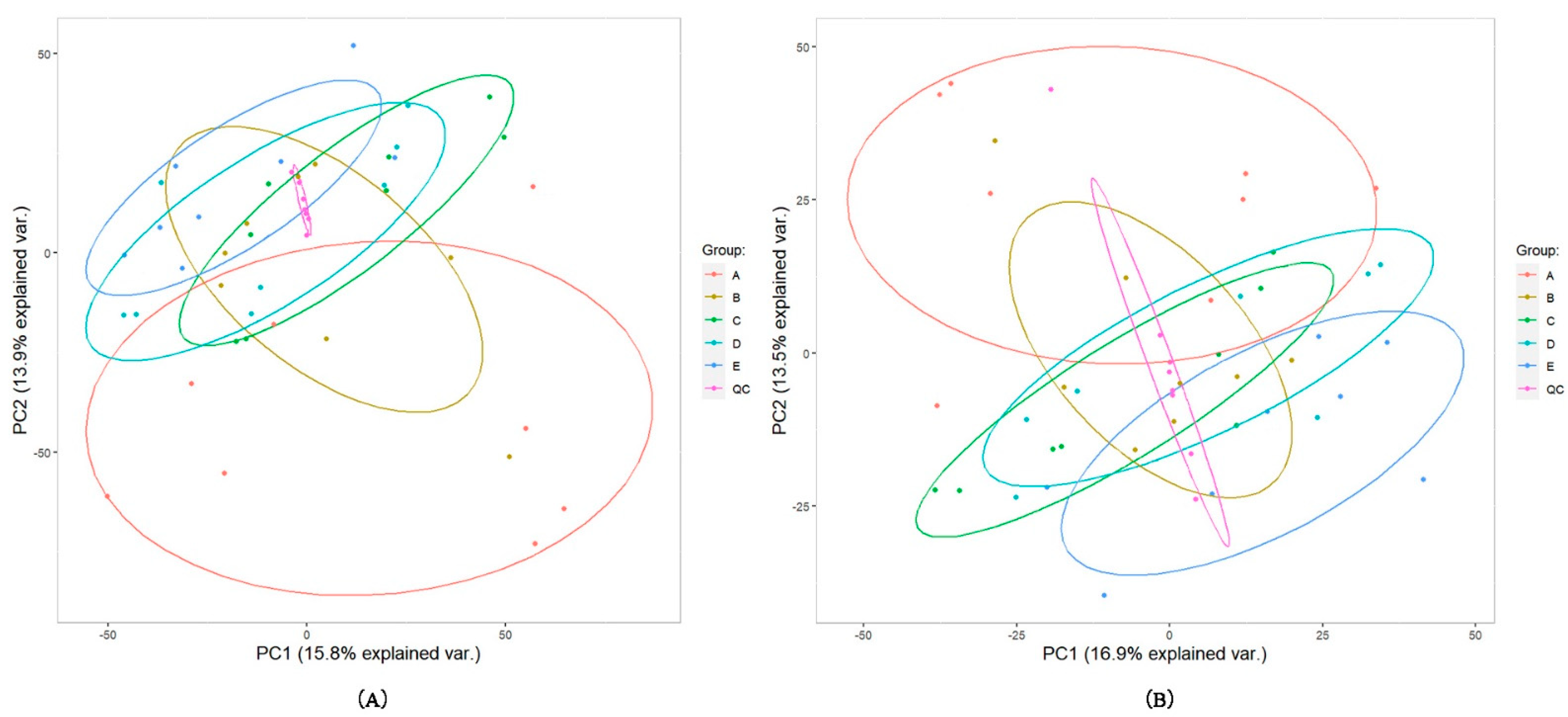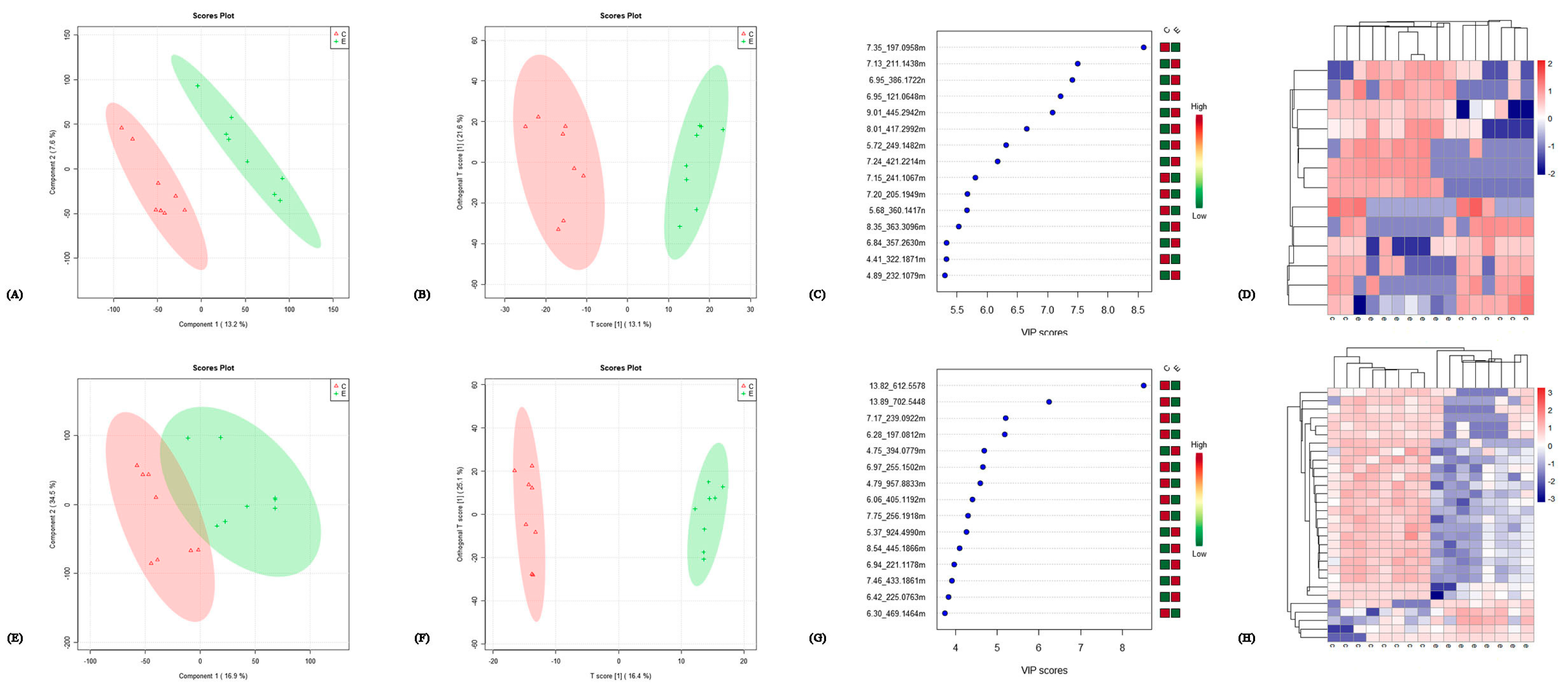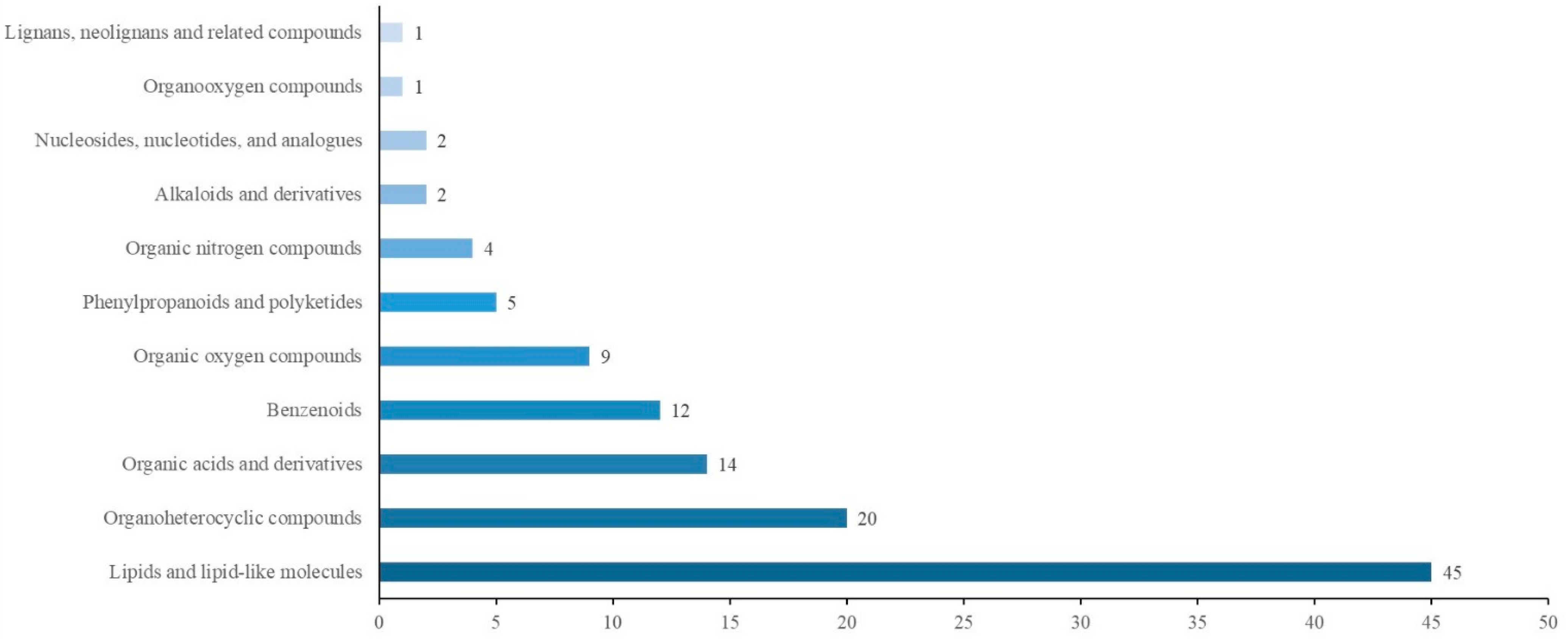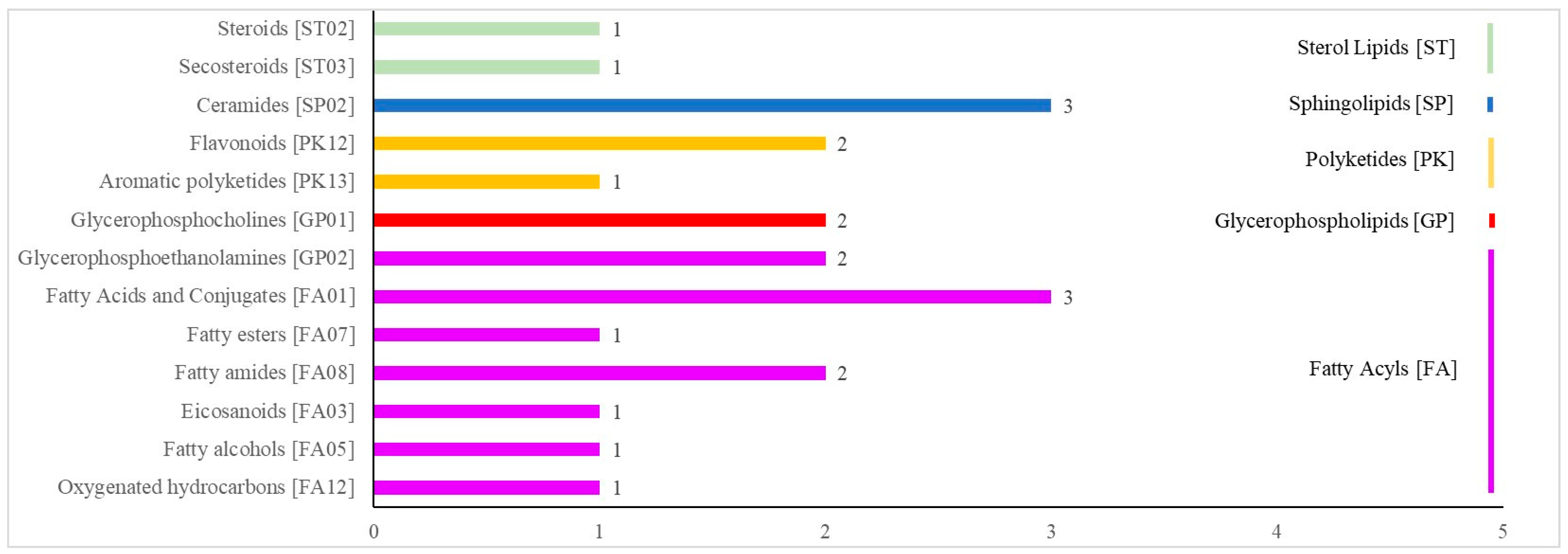The Effects of Postpartum Yak Metabolism on Reproductive System Recovery
Abstract
1. Introduction
2. Method and Materials
2.1. Experimental Design and Sample Collection
2.2. Detection of Main Substances in Serum
2.3. Metabolite Profiling Analysis
2.4. Raw Data Analysis and Multivariate Statistical Analysis
2.5. Bioinformatics Analysis of Differential Metabolites
3. Results
3.1. Change Trends of Major Serum Compounds during LPP
3.2. Profile of Yak Metabolism during LPP
3.3. Screening for Differential Metabolites
3.4. Bioinformatics Analysis
3.5. Identifying Key Differential Metabolites and Constructing the Metabolic Network
4. Discussion
4.1. Glucose Metabolism in Yaks during LPP
4.2. Lipid Metabolism of Female Yaks during LPP
4.3. Amino Acid Metabolism of Female Yaks during LPP
4.3.1. Glucogenic Amino Acids
4.3.2. Ketogenic Amino Acids
4.4. Synthesis and Secretion of Reproductive Hormones in Female Yaks during LPP
5. Conclusions
Supplementary Materials
Author Contributions
Funding
Institutional Review Board Statement
Informed Consent Statement
Data Availability Statement
Conflicts of Interest
References
- Qiu, Q.; Zhang, G.; Ma, T.; Qian, W.; Wang, J.; Ye, Z.; Cao, C.; Hu, Q.; Kim, J.; Larkin, D.M.; et al. The yak genome and adaptation to life at high altitude. Nat. Genet. 2012, 44, 946–949. [Google Scholar] [CrossRef] [PubMed]
- Guo, X.; Long, R.; Kreuzer, M.; Ding, L.; Shang, Z.; Zhang, Y.; Yang, Y.; Cui, G. Importance of functional ingredients in yak milk-derived food on health of Tibetan nomads living under high-altitude stress: A review. Crit. Rev. Food Sci. Nutr. 2014, 54, 292–302. [Google Scholar] [CrossRef] [PubMed]
- Long, R.J.; Zhang, D.G.; Wang, X.; Hu, Z.Z.; Dong, S.K. Effect of strategic feed supplementation on productive and reproductive performance in yak cows. Prev. Vet. Med. 1999, 38, 195–206. [Google Scholar] [CrossRef]
- Prakash, B.S.; Sarkar, M.; Mondal, M. An update on reproduction in yak and mithun. Reprod. Domest. Anim. 2008, 43 (Suppl. S2), 217–223. [Google Scholar] [CrossRef]
- Sarkar, M.; Borah, B.K.D.; Prakash, B.S. Strategies to optimize reproductive efficiency by regulation of ovarian function in yak (Poephagus grunniens L.). Anim. Reprod. Sci. 2009, 113, 205–211. [Google Scholar] [CrossRef]
- Lucy, M.C.; Butler, S.T.; Garverick, H.A. Endocrine and metabolic mechanisms linking postpartum glucose with early embryonic and foetal development in dairy cows. Animal 2014, 8 (Suppl. S1), 82–90. [Google Scholar] [CrossRef]
- Zi, X.D. Reproduction in female yaks (Bos grunniens) and opportunities for improvement. Theriogenology 2003, 59, 1303–1312. [Google Scholar] [CrossRef]
- Fu, M.; Xiong, X.R.; Lan, D.L.; Li, J. Molecular characterization and tissue distribution of estrogen receptor genes in domestic yak. Asian-Australas J. Anim. Sci. 2014, 27, 1684–1690. [Google Scholar] [CrossRef]
- Xiao, X.; Zi, X.D.; Niu, H.R.; Xiong, X.R.; Zhong, J.C.; Li, J.; Wang, L.; Wang, Y. Effect of addition of FSH, LH and proteasome inhibitor MG132 to in vitro maturation medium on the developmental competence of yak (Bos grunniens) oocytes. Reprod. Biol. Endocrinol. 2014, 12, 30. [Google Scholar] [CrossRef]
- Sarkar, M.; Meyer, H.H.; Prakash, B.S. Is the yak (Poephagus grunniens L.) really a seasonal breeder? Theriogenology 2006, 65, 721–730. [Google Scholar] [CrossRef]
- Yu, S.J.; Huang, Y.M.; Chen, B.X. Reproductive patterns of the yak. I. Reproductive phenomena of the female yak. Br. Vet. J. 1993, 149, 579–583. [Google Scholar]
- Liu, P.; Dong, Q.; Liu, S.; Degen, A.; Zhang, J.; Qiu, Q.; Jing, X.; Shang, Z.; Zheng, W.; Ding, L. Postpartum oestrous cycling resumption of yak cows following different calf weaning strategies under range conditions. Anim. Sci. J. 2018, 89, 1492–1503. [Google Scholar] [CrossRef] [PubMed]
- Quintans, G.; Vázquez, A.I.; Weigel, K.A. Effect of suckling restriction with nose plates and premature weaning on postpartum anestrous interval in primiparous cows under range conditions. Anim. Reprod. Sci. 2009, 116, 10–18. [Google Scholar] [CrossRef] [PubMed]
- Williams, G.L. Suckling as a regulator of postpartum rebreeding in cattle: A review. J. Anim. Sci. 1990, 68, 831–852. [Google Scholar] [CrossRef] [PubMed]
- Parfet, J.R.; Marvin, C.A.; Allrich, R.D.; Diekman, M.A.; Moss, G.E. Anterior pituitary concentrations of gonadotropins, GnRH-receptors and ovarian characteristics following early weaning in beef cows. J. Anim. Sci. 1986, 62, 717–722. [Google Scholar] [CrossRef] [PubMed]
- Crowe, M.A.; Diskin, M.G.; Williams, E.J. Parturition to resumption of ovarian cyclicity: Comparative aspects of beef and dairy cows. Animal 2014, 8 (Suppl. S1), 40–53. [Google Scholar] [CrossRef]
- Mackey, D.R.; Wylie, A.R.; Sreenan, J.M.; Roche, J.F.; Diskin, M.G. The effect of acute nutritional change on follicle wave turnover, gonadotropin, and steroid concentration in beef heifers. J. Anim. Sci. 2000, 78, 429–442. [Google Scholar] [CrossRef]
- Santos, J.E.P.; Rutigliano, H.M.; Filho, M.F.S. Risk factors for resumption of postpartum estrous cycles and embryonic survival in lactating dairy cows. Anim. Reprod. Sci. 2009, 110, 207–221. [Google Scholar] [CrossRef]
- Butler, W.R. Energy balance relationships with follicular development, ovulation and fertility in postpartum dairy cows. Livest. Prod. Sci. 2003, 83, 211–218. [Google Scholar] [CrossRef]
- Ribeiro, E.S.; Lima, F.S.; Greco, L.F.; Bisinotto, R.S.; Monteriro, A.P.A.; Favoreto, M.; Ayres, H.; Marsola, R.S.; Martinez, N.; Thatcher, W.W.; et al. Prevalence of periparturient diseases and effects on fertility of seasonally calving grazing dairy cows supplemented with concentrates. J. Dairy Sci. 2013, 96, 5682–5697. [Google Scholar] [CrossRef]
- Li, Z.; Jiang, M. Metabolomic profiles in yak mammary gland tissue during the lactation cycle. PLoS ONE 2019, 14, e0219220. [Google Scholar] [CrossRef] [PubMed]
- Liu, C.; Wu, H.; Liu, S.; Chai, S.; Meng, Q.; Zhou, Z. Dynamic Alterations in Yak Rumen Bacteria Community and Metabolome Characteristics in Response to Feed Type. Front. Microbiol. 2019, 10, 1116. [Google Scholar] [CrossRef] [PubMed]
- Gowda, G.A.; Djukovic, D. Overview of mass spectrometry-based metabolomics: Opportunities and challenges. Methods Mol. Biol. 2014, 1198, 3–12. [Google Scholar] [PubMed]
- Neumann, S.; Thum, A.; Böttcher, C. Nearline acquisition and processing of liquid chromatography-tandem mass spectrometry data. Metabolomics 2013, 9, 84–91. [Google Scholar] [CrossRef]
- Xu, W.; van Knegsel, A.; Saccenti, E.; van Hoeij, R.; Kemp, B.; Vervoort, J. Metabolomics of Milk Reflects a Negative Energy Balance in Cows. J. Proteome Res. 2020, 19, 2942–2949. [Google Scholar] [CrossRef]
- Saraf, K.K.; Kumaresan, A.; Dasgupta, M.; Karthikkeyan, G.; Prasad, T.S.K.; Modi, P.K.; Ramesha, K.; Jeyakumar, S.; Manimaran, A. Metabolomic fingerprinting of bull spermatozoa for identification of fertility signature metabolites. Mol. Reprod. Dev. 2020, 87, 692–703. [Google Scholar] [CrossRef]
- Xu, W.; Vervoort, J.; Saccenti, E.; Kemp, B.; van Hoeij, R.J.; van Knegsel, A.T.M. Relationship between energy balance and metabolic profiles in plasma and milk of dairy cows in early lactation. J. Dairy Sci. 2020, 103, 4795–4805. [Google Scholar] [CrossRef]
- Hankele, A.K.; Rehm, K.; Berard, J.; Schuler, G.; Bigler, L.; Ulbrich, S.E. Progestogen profiling in plasma during the estrous cycle in cattle using an LC-MS based approach. Theriogenology 2020, 142, 376–383. [Google Scholar] [CrossRef]
- Tabatabaei, M.S.; Ahmed, M. Enzyme-Linked Immunosorbent Assay (ELISA). Methods Mol. Biol. 2022, 2508, 115–134. [Google Scholar]
- Hammon, H.M.; Steinhoff-Wagner, J.; Flor, J.; Schönhusen, U.; Metges, C.C. Lactation Biology Symposium: Role of colostrum and colostrum components on glucose metabolism in neonatal calves. J. Anim. Sci. 2013, 91, 685–695. [Google Scholar] [CrossRef]
- Steeves, T.E.; Gardner, D.K. Metabolism of glucose, pyruvate, and glutamine during the maturation of oocytes derived from pre-pubertal and adult cows. Mol. Reprod. Dev. 1999, 54, 92–101. [Google Scholar] [CrossRef]
- White, H.M. The Role of TCA Cycle Anaplerosis in Ketosis and Fatty Liver in Periparturient Dairy Cows. Animals 2015, 5, 793–802. [Google Scholar] [CrossRef] [PubMed]
- Bava, L.; Rapetti, L.; Crovetto, G.M.; Tamburini, A.; Sandrucci, A.; Galassi, G.; Succi, G. Effects of a nonforage diet on milk production, energy, and nitrogen metabolism in dairy goats throughout lactation. J. Dairy Sci. 2001, 84, 2450–2459. [Google Scholar] [CrossRef]
- Fassah, D.M.; Jeong, J.Y.; Baik, M. Hepatic transcriptional changes in critical genes for gluconeogenesis following castration of bulls. Asian-Australas J. Anim. Sci. 2018, 31, 537–547. [Google Scholar] [CrossRef] [PubMed]
- Yu, X.; Peng, Q.; Luo, X.; An, T.; Guan, J.; Wang, Z. Effects of Starvation on Lipid Metabolism and Gluconeogenesis in Yak. Asian-Australas J. Anim. Sci. 2016, 29, 1593–1600. [Google Scholar] [CrossRef]
- Honoré, A.H.; Thorsen, M.; Skov, T. Liquid chromatography-mass spectrometry for metabolic footprinting of co-cultures of lactic and propionic acid bacteria. Anal. Bioanal. Chem. 2013, 405, 8151–8170. [Google Scholar] [CrossRef]
- Frye, R.E.; Rose, S.; Chacko, J.; Wynne, R.; Bennuri, S.C.; Slattery, J.C.; Tippett, M.; Delhey, L.; Melnyk, S.; Kahler, S.G.; et al. Modulation of mitochondrial function by the microbiome metabolite propionic acid in autism and control cell lines. Transl. Psychiatry 2016, 6, e927. [Google Scholar] [CrossRef]
- Zhang, Z.; Emami, S.; Hennebelle, M.; Morgan, R.K.; Lerno, L.A.; Slupsky, C.M.; Lein, P.J.; Taha, A.Y. Linoleic acid-derived 13-hydroxyoctadecadienoic acid is absorbed and incorporated into rat tissues. Biochim. Biophys. Acta Mol. Cell Biol. Lipids 2021, 1866, 158870. [Google Scholar] [CrossRef]
- Szczuko, M.; Kikut, J.; Komorniak, N.; Bilicki, J.; Celewicz, Z.; Ziętek, M. The Role of Arachidonic and Linoleic Acid Derivatives in Pathological Pregnancies and the Human Reproduction Process. Int. J. Mol. Sci. 2020, 21, 9628. [Google Scholar] [CrossRef]
- Zhao, J.; Liu, Q.; Liu, Y.; Qiao, W.; Yang, K.; Jiang, T.; Hou, J.; Zhou, H.; Zhao, Y.; Lin, T.; et al. Quantitative profiling of glycerides, glycerophosphatides and sphingolipids in Chinese human milk with ultra-performance liquid chromatography/quadrupole-time-of-flight mass spectrometry. Food Chem. 2021, 346, 128857. [Google Scholar] [CrossRef]
- Judge, A.; Dodd, M.S. Metabolism. Essays Biochem. 2020, 64, 607–647. [Google Scholar] [CrossRef] [PubMed]
- Sutton, J.D.; Dhanoa, M.S.; Morant, S.V.; France, J.; Napper, D.J.; Schuller, E. Rates of production of acetate, propionate, and butyrate in the rumen of lactating dairy cows given normal and low-roughage diets. J. Dairy Sci. 2003, 86, 3620–3633. [Google Scholar] [CrossRef]
- Moraes, G.; Altran, A.E.; Avilez, I.M.; Barbosa, C.C.; Bidinotto, P.M. Metabolic adjustments during semi-aestivation of the marble swamp eel (Synbranchus marmoratus, Bloch 1795)--a facultative air breathing fish. Braz. J. Biol. 2005, 65, 305–312. [Google Scholar] [CrossRef] [PubMed]
- Bonifácio, V.D.B.; Pereira, S.A.; Serpa, J.; Vicente, J.B. Cysteine metabolic circuitries: Druggable targets in cancer. Br. J. Cancer 2021, 124, 862–879. [Google Scholar] [CrossRef] [PubMed]
- Curi, R.; Newsholme, P.; Pithon-Curi, T.C.; Pires-de-Melo, M.; Garcia, C.; Júnior, P.I.H.; Guimarães, A.R. Metabolic fate of glutamine in lymphocytes, macrophages and neutrophils. Braz. J. Med. Biol. Res. 1999, 32, 15–21. [Google Scholar] [CrossRef]
- Xiao, D.; Zeng, L.; Yao, K.; Kong, X.; Wu, G.; Yin, Y. The glutamine-alpha-ketoglutarate (AKG) metabolism and its nutritional implications. Amino Acids 2016, 48, 2067–2080. [Google Scholar] [CrossRef]
- Platten, M.; Nollen, E.A.A.; Röhrig, U.F.; Fallarino, F.; Opitz, C.A. Tryptophan metabolism as a common therapeutic target in cancer, neurodegeneration and beyond. Nat. Rev. Drug Discov. 2019, 18, 379–401. [Google Scholar] [CrossRef]
- Endo, F.; Tanaka, Y.; Tomoeda, K.; Tanoue, A.; Tsujimoto, G.; Nakamura, K. Animal models reveal pathophysiologies of tyrosinemias. J. Nutr. 2003, 133, 2063s–2067s. [Google Scholar] [CrossRef]
- Hase, A.; Jung, S.E.; Rot, M. Behavioral and cognitive effects of tyrosine intake in healthy human adults. Pharmacol. Biochem. Behav. 2015, 133, 1–6. [Google Scholar] [CrossRef]
- Liu, Y.; Xu, Y.; Ding, D.; Wen, J.; Zhu, B.; Zhang, D. Genetic engineering of Escherichia coli to improve L-phenylalanine production. BMC Biotechnol. 2018, 18, 5. [Google Scholar] [CrossRef]
- Suzuki, R.; Sato, Y.; Fukaya, M.; Suzuki, D.; Yoshizawa, F.; Sato, Y. Energy metabolism profile of the effects of amino acid treatment on hepatocytes: Phenylalanine and phenylpyruvate inhibit glycolysis of hepatocytes. Nutrition 2021, 82, 111042. [Google Scholar] [CrossRef] [PubMed]
- Wang, R.; Hartmann, M.F.; Wudy, S.A. Targeted LC-MS/MS analysis of steroid glucuronides in human urine. J. Steroid. Biochem. Mol. Biol. 2021, 205, 105774. [Google Scholar] [CrossRef] [PubMed]
- Xu, H.; Zhou, S.; Tang, Q.; Xia, H.; Bi, F. Cholesterol metabolism: New functions and therapeutic approaches in cancer. Biochim. Biophys. Acta Rev. Cancer 2020, 1874, 188394. [Google Scholar] [CrossRef] [PubMed]
- Qian, H.; Pan, Z.; Wang, X.; Lu, T.; Fang, Z. Effects of Dietary Restriction on Cholesterol Metabolism in Liver and Adrenal Gland of Mice. Chin. J. Anim. Nutr. 2018, 30, 2281–2293. [Google Scholar]
- Miller, W.L.; Auchus, R.J. The molecular biology, biochemistry, and physiology of human steroidogenesis and its disorders. Endocr. Rev. 2011, 32, 81–151. [Google Scholar]
- Adhikari, M.; Negi, B.; Kaushik, N.; Adhikari, A.; Al-Khedhairy, A.A.; Kaushik, N.K.; Choi, E.H. T-2 mycotoxin: Toxicological effects and decontamination strategies. Oncotarget 2017, 8, 33933–33952. [Google Scholar] [CrossRef]






 ” direct effect; “
” direct effect; “ ” omit part of the process; “
” omit part of the process; “ ” same metabolite; and “
” same metabolite; and “ ” inhibition; “×” bloked.
” inhibition; “×” bloked.
 ” direct effect; “
” direct effect; “ ” omit part of the process; “
” omit part of the process; “ ” same metabolite; and “
” same metabolite; and “ ” inhibition; “×” bloked.
” inhibition; “×” bloked.
| HMDB_ID | Description | Abbreviation | UP or DOWN | |
|---|---|---|---|---|
| HMDB0005821 | Beta-cortol | Cor | E/A | UP |
| HMDB0000949 | Tetrahydrocortisol | TH-Cor | D/B | UP |
| HMDB0032864 | Mycotoxin T 2 | MT2 | E/A | DOWN |
| HMDB0010166 | PS(18:0/22:5(7Z,10Z,13Z,16Z,19Z)) | PS | C/A E/A | UP UP |
| HMDB0043117 | TG(15:0/22:0/22:1(13Z)) | TG | C/A | UP |
| HMDB0008850 | PE(14:0/P-16:0) | PE | C/A | UP |
| HMDB0030254 | Propanoic acid | Pac | E/A E/C E/D | DOWN DOWN DOWN |
| HMDB0004667 | 13S-hydroxyoctadecadienoic acid | 13-HODE | D/A | DOWN |
| HMDB0006940 | 9(S)-HPODE | 9-HODE | D/A D/B | DOWN DOWN |
| HMDB0007931 | PC(14:1(9Z)/P-18:1(9Z)) | PC | E/C | DOWN |
| HMDB0007961 | PC(15:0/P-16:0) | PC | C/A E/B E/C | UP DOWN DOWN |
| HMDB0008064 | PC(18:1(11Z)/14:0) | PC | D/C E/A E/B E/C | DOWN DOWN DOWN DOWN |
| HMDB0008394 | PC(20:3(8Z,11Z,14Z)/14:0) | PC | D/C E/C | DOWN DOWN |
| HMDB0008892 | PE(15:0/18:0) | PE | E/A E/C E/D | DOWN DOWN DOWN |
| HMDB0008916 | PE(15:0/P-16:0) | PE | E/C | DOWN |
| HMDB0009048 | PE(18:1(11Z)/P-16:0) | PE | D/C E/C | DOWN DOWN |
| HMDB0009378 | PE(20:3(8Z,11Z,14Z)/P-16:0) | PE | E/C | DOWN |
| HMDB0011386 | PE(P-18:0/20:4(8Z,11Z,14Z,17Z)) | PE | E/C | DOWN |
| HMDB0011401 | PE(P-18:1(11Z)/14:0) | PE | E/C | DOWN |
| HMDB0011403 | PE(P-18:1(11Z)/15:0) | PE | E/C | DOWN |
| HMDB0011416 | PE(P-18:1(11Z)/20:3(5Z,8Z,11Z)) | PE | E/C | DOWN |
| HMDB0010569 | PE-NMe(16:0/18:1(9Z)) | PE | E/B E/C | DOWN DOWN |
| HMDB0028716 | Arginyl-phenylalanine | Arg-Phe | C/A | UP |
| HMDB0003339 | D-glutamic acid | D-Glu | D/B | UP |
| HMDB0001049 | Gamma-glutamylcysteine | Gln-Cys | E/B | UP |
| HMDB0000759 | Glycylleucine | Gly | D/A E/A | UP UP |
| HMDB0060484 | Indolepyruvate | Ipa | E/A | UP |
| HMDB0001896 | 5-Methoxytryptophol | Trp | E/C | DOWN |
| HMDB0029081 | Tryptophyl-glutamine | Trp-Gln | C/A D/A E/D | DOWN DOWN UP |
Publisher’s Note: MDPI stays neutral with regard to jurisdictional claims in published maps and institutional affiliations. |
© 2022 by the authors. Licensee MDPI, Basel, Switzerland. This article is an open access article distributed under the terms and conditions of the Creative Commons Attribution (CC BY) license (https://creativecommons.org/licenses/by/4.0/).
Share and Cite
Shu, S.; Fu, C.; Wang, G.; Peng, W. The Effects of Postpartum Yak Metabolism on Reproductive System Recovery. Metabolites 2022, 12, 1113. https://doi.org/10.3390/metabo12111113
Shu S, Fu C, Wang G, Peng W. The Effects of Postpartum Yak Metabolism on Reproductive System Recovery. Metabolites. 2022; 12(11):1113. https://doi.org/10.3390/metabo12111113
Chicago/Turabian StyleShu, Shi, Changqi Fu, Guowen Wang, and Wei Peng. 2022. "The Effects of Postpartum Yak Metabolism on Reproductive System Recovery" Metabolites 12, no. 11: 1113. https://doi.org/10.3390/metabo12111113
APA StyleShu, S., Fu, C., Wang, G., & Peng, W. (2022). The Effects of Postpartum Yak Metabolism on Reproductive System Recovery. Metabolites, 12(11), 1113. https://doi.org/10.3390/metabo12111113





